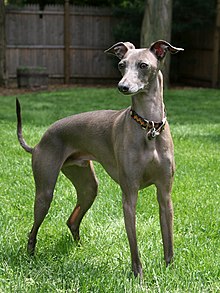Italian Greyhound
| Italian Greyhound | |||||||||||||||||||||
|---|---|---|---|---|---|---|---|---|---|---|---|---|---|---|---|---|---|---|---|---|---|
 | |||||||||||||||||||||
| Other names |
| ||||||||||||||||||||
| Origin | Italy | ||||||||||||||||||||
| |||||||||||||||||||||
| |||||||||||||||||||||
| Dog (domestic dog) | |||||||||||||||||||||
The Italian Greyhound (Italian: Piccolo levriero Italiano) is an Italian breed of small sighthound. It may also be called the Italian Sighthound.
History

Small dogs of sighthound type have long been popular with nobility and royalty. Among those believed to have kept them are Frederick II, Duke of Swabia; members of the D'Este, Medici and Visconti families; the French kings Louis XI, Charles VIII, Charles IX, Louis XIII and Louis XIV;[2] Frederick the Great of Prussia;[3]: 519 Anne of Denmark; Catherine the Great and Queen Victoria.[4] Dogs of this type have often been represented in paintings, notably by Giotto, Sassetta and Tiepolo.[2]
Dogs of this kind were taken in the first half of the nineteenth century to the United Kingdom, where they were known as Italian Greyhounds.[5]: 44 The first volume of The Kennel Club Calendar and Stud Book, published in 1874, lists forty of them.[6]: 597 The first breed association was the Italian Greyhound Club, founded in Britain in 1900.[7][8]: 157 Registrations by the American Kennel Club began in 1886.[4]
In the nine years from 2011 to 2019, the Ente Nazionale della Cinofilia Italiana recorded a total of 2557 new registrations of the Piccolo Levriero, with a minimum of 213 and a maximum of 333 per year.[2]
Characteristics

The Italian Greyhound is the smallest of the sighthounds.[4] It weighs no more than 5 kg and stands 32 to 38 cm at the withers.[1]
It is deep in the chest, with a tucked-up abdomen, long slender legs and a long neck. The head is small; it is elongated and narrow.[1] The gait should be high-stepping and well-sprung, with good forward extension in the trot, and a fast gallop.[1]
The coat may be solid black, grey or isabelline; white markings are accepted on the chest and feet only.[1]
Life expectancy is about 14 years.[9]: 127 [10]: 127 In the United States, the Ortheopedic Foundation for Animals has found the Italian Greyhound to be the least affected by hip dysplasia of 157 breeds studied, with an incidence of 0.[11]
Use
The original function of the Piccolo Levriero was to hunt hare and rabbit; it is capable of bursts of speed up to 60 km/h (37 mph).[12] Although assigned to the sighthound or hare-coursing groups by the Fédération Cynologique Internationale and the Ente Nazionale della Cinofilia Italiana,[13][2] the Italian Sighthound is – as it was in the past – kept mostly as a companion dog.[14] It is classified as a toy breed by the American Kennel Club and the Kennel Club of the United Kingdom.[4][15]
References
- ^ a b c d e f Piccolo levriero italiano (in Italian). Ente Nazionale della Cinofilia Italiana. Accessed February 2020.
- ^ a b c d Piccolo levriero italiano: Storia (in Italian). Ente Nazionale della Cinofilia Italiana. Accessed February 2020.
- ^ Desmond Morris (2001). Dogs: A Dictionary of Dog Breeds. London: Ebury. ISBN 9780091870911.
- ^ a b c d Italian Greyhound Dog Breed Information. American Kennel Club. Accessed March 2021.
- ^ John Henry Walsh ("Stonehenge") (1859). The dog, in health and disease. London: Longman, Green, Longman, and Roberts.
- ^ Frank C. S. Pearce (1874). The Kennel Club Calendar and Stud Book, volume 1. London: for the Kennel Club.
- ^ Circolo del Piccolo Levriero Italiano (in Italian). Circolo del Piccolo Levriero Italiano. Archived 14 June 2004.
- ^ Cecil Gordon Eugene Wimhurst (1900). The Complete Book of Toy Dogs. New York: Putnam.
- ^ [Bruce Fogle] (2013). The Dog Encyclopedia. London; New York: Dorling Kindersley. ISBN 9781465408440.
- ^ Kim Dennis-Bryan, Tracy Morgan (2020). The Complete Dog Breed Book. London: Dorling Kindersley. ISBN 9780241412732.
- ^ Hip Dysplasia Statistics. Ortheopedic Foundation for Animals. Archived 10 February 2010.
- ^ Piccolo Levriero Italiano (in Italian). Ente Nazionale della Cinofilia Italiana. Archived 7 July 2014.
- ^ Piccolo levriero italiano (200). Fédération Cynologique Internationale. Accessed February 2020.
- ^ Cenni Storici (in Italian). Circolo del Piccolo Levriero Italiano. Archived 15 June 2004.
- ^ Italian Greyhound. The Kennel Club. Accessed March 2021.
Further reading
- Maria Luisa Incontri Della Stufa (1956). Il piccolo levriero italiano nell'arte e nella storia (in Italian). Firenze: Sansoni.
- [s.n.] (2004). Le razze italiane (in Italian). Milano: Ente Nazionale della Cinofilia.
